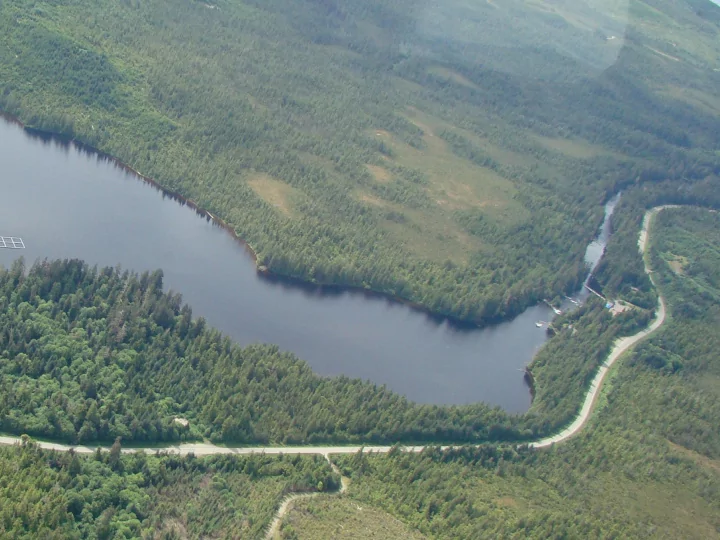

Brief History of the Klawock River Hatchery (KRH) 1897 : one of first hatchery sites in Alaska (sockeye) 1977/1978 : state builds current hatchery (chum and steelhead) About 1980 : state discontinues chum salmon (IHN virus in sockeye in watershed) and begins coho production: coho are reared in net to pre-smolt size and released in the lake in the fall. About 1990 : to avoid preying on sockeye in Klawock Lake, Coho are held in net pens through the winter and released in the spring of the year. Steelhead are still produced at the site with some production of sockeye fry in water from 3-mile creek. The water source has competing users – sockeye production is intermittent . Early to mid 1990’s: FRED Division dissolves and state hatcheries are leased to private operators. 1996: POWHA assumes operation of the hatchery. Permitted capacity is for 5 million fall coho eggs, 5 million sockeye eggs, and 50,000 steelhead eggs. Coho are reared to smolt in Klawock Lake and released in the spring.
Recent History of POWHA • 1996 to 2010: – All coho are reared in net pens in Klawock Lake and released June 1 when they will go directly to saltwater. – Broodstock goals were not always met. – Historically coded wire tagging was not consistent or reliable between years and it was difficult if not impossible to determine common property harvest or total return/survival. – Cost recovery goals were never met and consequently POWHA took numerous operational loans from the state. – Lack of revenue resulted in degradation of equipment such as net pens and its possible the fish were not always fed an optimal amount of feed. It also made it difficult to attract competent fish culture personnel. – Sometime in late 2010 or early 2011 it was clear to the state, ADF&G and Department of Investments, that on it’s current course it was very unlikely POWHA would continue to exist. The state set up a meeting of all parties in Klawock. Several conclusions came from the meeting: • the State and SSRAA would assist POWHA with the fish culture practices ; • the State would make subsequent loans to POWHA to the limit of their collateral; • POWHA make significant internal modification to their staff and administration.
Current KRH Permitted Capacity • Fall Coho, current stock: 5 million green eggs, usually resulting in a release of 4.5 million yearling smolt. • Sockeye: 1 million green eggs. Note that though the facility has a permitted capacity for sockeye eggs, there are no existent Fish Transport Permits (FTP’s) for sockeye. Though the hatchery is permitted for the eggs, the legal document allowing collection and transport of eggs or resultant fry is the FTP. Without an FTP in place the permit currently does not allow for sockeye production. Last release in 2005. • Steelhead: 0 green eggs. Note Klawock has not raised steelhead since 2002 and they no longer have any FTP’s for steelhead.
KRH 2011 to Present and Beyond 1. New fish culture procedures were adapted and existing procedures were modified to increase the survival of coho released from Klawock River Hatchery (KRH). This included replacing deteriorated equipment including rearing nets; improving coded wire tagging procedures; optimally feeding the fish; and deploying new rearing strategies including net pens in the estuary. 2. A long-term fish culturist with diverse experience and success in salmon culture was employed. 3. Significant numbers of adults returned from 2013 to present: - The average survival to adult during this period is 5.6%, ranging between 4.2%-7.3%. - The common property harvest during this period is over 814,000 adult coho, worth several million dollars, primarily benefitting the troll fleet. 4. Southern Southeast Regional Aquaculture Association (SSRAA) assumed operations of KRH in July 2016. POWHA officially dissolved on February 1, 2017. 5. Permits were altered to allow us to release all of the coho production from the estuary, 2015. 6. Port Asumcion release site operational in 2018. Currently permitted for 8 million chum and 400,000 coho. Eventually move more coho production to this site and release less at hatchery.
Fish passed to Klawock Lake 1994-2017 Coho mitigation number is 6,360 1994-2017 Returns to Klawock River Weir by Species and passed into Lake Year Sockeye Sockeye Jacks Coho Coho Jacks Pinks Chum 1994 13,152 NA 8,444 NA 1995 14,690 0 9,800 200 1996 3,500 38 2,652 50 1997 1,800 85 6,000 753 1998 2,070 280 9,023 1,781 1999 4,749 84 8,506 0 2000 9,151 27 9,513 3,548 2001 6,914 829 4,858 952 2002 13,255 0 13,913 3,770 2003 6,262 252 5,997 4,919 2004 10,854 721 4,040 11,200 2005 12,509 2,394 8,867 2,387 2006 12,771 2,037 NA NA 2007 NA NA 8,208 4,579 2008 18,002 3,130 6,210 2,566 2009 16,560 3,139 4,612 2,230 2010 21,549 1,190 9,707 1,216 2011 4,312 474 3,343 3,421 2012 2,228 390 4,507 7,687 2,180 3 2013 1,086 531 8,323 5,118 158,478 50 2014 5,911 285 7,698 5,620 18,873 8 2015 7,696 1,108 12,780 19,733 63,906 25 2016 6,210 695 24,242 14,061 6,875 24 2017 12,535 1,192 6,500 16,259 24,470 12 Totals 207,766 18,881 187,743 112,050 274,782 122 Adult coho and jack coho return numbers are preliminary for 2017
Recommend
More recommend